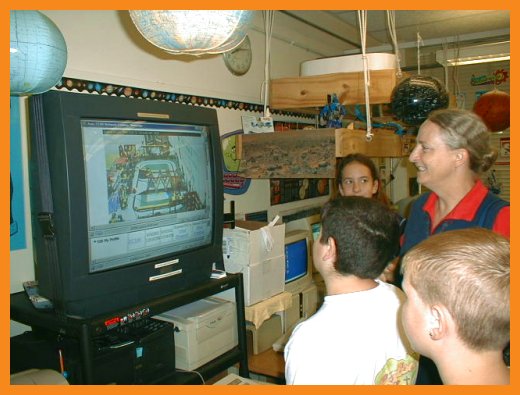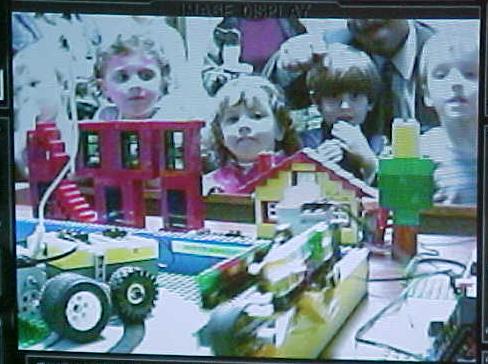Linda Hamilton
Marshall University Mathematics Instructor
LEGO Specialist at Rahall Transportation
Institute
SENSORS CITY Science and Engineering
NASA Site of Remote Sensing
hamilton@marshall.edu
Linda Hamilton
Marshall University Mathematics Instructor
LEGO Specialist at Rahall Transportation
Institute
SENSORS CITY Science and Engineering
NASA Site of Remote Sensing
hamilton@marshall.edu
My Red Rover Red Rover experience started when its developer was still at Utah State University. Working on the program at Davis Creek interested the LEGO company and I was asked to beta test. The Planetary Society extended the Red Rover program to Red Rover Goes to Mars � having students actually involved with NASA projects.
Mars Stations use a version of the Red Rover program that is run through the web. As the real Mars Rovers traveled to Mars, Mars Stations were set up to allow people of the world to experience the excitement of operating rovers from afar. I had the Marshall University Education department set up Mars South Pole. Now I have it at the Nick J. Rahall, II Appalachian Transportation Institute (RTI).
The LEGO City at Marshall University is also a Mars Station. Mars Stations are designed to give everyone the experience of exploring an unknown world through the eyes of a robotic rover. The Planetary Society and LEGO Company have teamed together to establish a network of Mars Stations around the world. Each station contains a LEGO® rover equipped with a Web camera that you can drive over the Internet.
Each Mars Station consists of a diorama representing an area of Mars. Robotic rovers made out of LEGO® components drive around the diorama, investigating the alien terrain. The rovers are equipped with Web cameras and are connected to a computer on the Internet. Visitors to the Mars Station�s website simply log in to the Mars Station computer and operate the rover.
Mars Stations grew out of the highly successful
Red Rover, Red Rover project. Red Rover, Red Rover and Exploration Mars
allow classrooms or home users to construct robotic rovers out of LEGO
Technic bricks, motors, and wheels, complete with a Web camera to serve
as the robot's "eyes." Software included with Red Rover, Red Rover and
Exploration Mars permits driving the rover from a PC-compatible computer,
exploring its environment through the Web camera.
http://www.marshall.edu/CITY
has a link for instructions for setting up a free GUI to operate the LEGO.marshall.edu
site.
The LEGO 24-Hour City of Nick J Rahall, II Appalachian Transportation Institute (RTI) is an official Science and Engineering NASA Site of Remote Sensing (SENSORS). SENSORS is a NASA Leading Educators to Applications, Research, and NASA related Educational Resources in Science Cooperative Agreement Notice (LEARNERS CAN). The purpose of LEARNERS CAN is to enhance K-12 science, math, technology, and geography education through Internet based products derived from NASA mission content. With the use of tele-robotics and LEGO RCX robots, students can explore and discover different environments.
The Appalachian Transportation Institute is located at Marshall University in Huntington, West Virginia. One of the goals of RTI is to provide quality transportation-related programs to elementary, middle, and high school students, with the express purpose of attracting students to careers in transportation fields. Each year, a variety of workshops are sponsored which enable students to explore the technologies and issues related to transportation in the United States.
The LEGO 24-Hour City at RTI is built around the LEGO Educational RCX intelligent programmable brick. Using LEGO ROBOLAB software, students at RTI are able to program each of the city's vehicles and traffic control elements. Previously, using Red Rover software, students at other sites could remotely activate the motors and lights on the City's LEGO models and run set up programs. Now, using the Internet, students from anywhere can also program the City's elements themselves and remotely receive information and data from the City. Linda Hamilton, mathematics instructor at Marshall University, working with Chris Rogers of Tufts University Center for Engineering Educational Outreach, has designed the LEGO 24-Hour City at RTI to be operational for remote sensing. Many schools have remotely operated the City's monorail, gates, traffic counters, and vehicles.
Remote sensing is becoming increasingly useful in real-life traffic situations. An example would be pre-paid passes that enable vehicles to pass through interstate toll areas without stopping. Use of such technology helps commuters to plan better routes and improves traffic flow.
Programs like the LEGO 24-Hour City at RTI use hands-on, real-life activities that build interest in engineering, robotics, and remote sensing among young people. This interest may well stay with the students throughout their education and lead them to careers in transportation and traffic fields. A SENSORS LEGO Robotics Workshop was held at Tufts University on June 6-8, 2001. Marshall University, NASA Jet Propulsion Laboratory, NASA Glenn, NASA Goddard and NASA Ames representatives planned their SENSORS site and programmed LEGO robotics at the Tufts University SENSORS workshop.
The LEGO City uses LEGO robotics to demonstrate
Intelligent Transportation Systems (ITS). It is a high-tech city
model complete with roads, bridges, and traffic incorporating intelligent
transportation systems such as sensors to control and monitor traffic.
The site available to K-12 classroom teachers
to have as hands on learning modules for their students to learn abstract
math and science concepts. At the college level, the city is used in teacher
training, and in my math classes.
The city uses RoboLab, LabView software,
to enable students run programs to operate the vehicles and receive back
sensor data. This is the same software used to drive the PathFinder
on Mars and is used for NASA programs.
Getting data remotely appeared to be easy for three groups of 6th graders today.
Transportation models are set up at Marshall University using
LEGO Dacta Cities and Transportation materials that include gears, pulleys, motors, beams, plates,
light sensors, touch sensors, and the RCX - the LEGO microprocessor.
From the computers in their rooms, the students logged onto http://netapps.marshall.edu/lego
They checked out some pictures showing what some of their classmates have done this current year.
Back on the http://netapps.marshall.edu/lego page under the rover picture they clicked the LEGO camera to see a live picture of the CITY.
For the month of December there is a rather large Holiday Helper Elf watching the monorail.
Clicking on SENSORSCITY link which is http://SENSORSCITY.marshall.edu, each group went to work.
They made an account with a name and password they would remember, checked out the schedule, and signed up for a time slot.
Some chose programs to run from those at the site at
http://sensorscity.marshall.edu/city/pages/vi
while they looked through the pictures and descriptions of the scenarios.
Others wrote or changed programs using the RoboLab they had.
In one room they also watched and operated the CITY with Red Rover soft ware.See instructions to try out Red Rover at the City at http://netapps.marshall.edu/lego/city
The fun came in submitting missions to SENSORS CITY and having the monorail move while watching over the Internet on the live camera.
The little car models traffic moving. The data that comes back over the internet
as a graph makes it much easier to count the car rate.
Putting this all together was a learning
experience about how interconnected the space flights from NASA must be.
Building, operating and programming a LEGO rover is modeling the teleoperation
of a Mars rover to do scientific exploration. However, there is even
more learning than that. Students learn to work together, learn of
other places and cultures, and how others live, learn, and work together.
We are not just a society that is contained in a small area or school.
There are multitudes of interactions that make differences to us daily.
Mrs. Simon, the 5th grade teacher at Davis
Creek with whom this entire Davis Creek Red Rover project is based, made
email pals with an Australian classroom. For three years, the culmination
of the Australian school year was to have a Rover drive and see the
email pals at Davis Creek.
Homer Hickam, author of the book Rocket Boys, met with Jay Hamilton Drost and the RED ROVER. Homer spoke about his life leading up to being a NASA engineer at the book signing at the Huntington Public Library before his movie "October Skies" came out in 1999. Jay talked to him about the Mars Red Rover project at Davis Creek Elementary that uses LEGO elements, camera and computer to simulate the Mars rover. It has been driven over the Internet from near and as far as Australia.
Doing and seeing is great for learning science. As in real space exploration, being at remote places is not always possible. It would be great to be on Mars - but so far only traveling around on Mars has been by robotics. Students at Davis Creek Elementary, Barboursville Middle and Big Creek High tried their hand at modeling that exploration with LEGO robotics. Programming autonomous rovers and teleoperating rovers with RED ROVER software modeled some of the aspects of space exploration. Students have developed solutions to the problems that arise in process of moving around with only information from the camera and sensors. They have been able to accomplish tasks such as gathering samples remotely.
However, as in real exploration, there
needs to be a way to get the material back to earth. The challenge
was to launch a rocket remotely. After all there is no one on Mars
to push the button.
Connected through the internet on RED
ROVER, Big Creek, Davis Creek, and Barboursville drove rovers. The newscasters
were seen by the students at Davis Creek and Big Creek through the camera
connected to the computer in Mrs. Bickel's middle school room. Mrs. Simon
at Davis Creek Elementary took pictures of the computer pictures that were
seen there. The Barboursville FIRST LEGO League talked with TV News.


See the Current
Set Up.
Write programs in RoboLab
or use example
programs.
Save the .vi program
to you computer.
Log in http://SENSORSCITY.marshall.edu/CITY/
After getting into
the homepage, follow the headings on the left-hand side of the page.
View Schedule and sign up for a time slot.
Submit a mission. (See example submit mission.)
Watch on live video.
Get your mission results.
The physical set up of the LEGO City uses
LEGO Educational Cities and Transportation sets.
Note:
Lamp on port A is across from the light sensor on port 1.
Monorail motor is on port B and touch sensors on both ends of the track
are on port 2.
Port C varies each month and port 3 is a light sensor.
Instructions for operating the SENSORSCITY
with RED ROVER software are on http://netapps.marshall.edu/lego/CITY.
Teleoperate on the web at http:/lego.marshall.edu
See live camera view of the LEGO CITY
on http://legocamera.marshall.edu/.
Note: At this point in the presentation we will work with the LEGO Robotics hands-on and over the Internet.
Linda
Hamilton
hamilton@marshall.edu